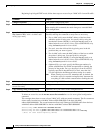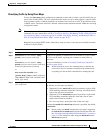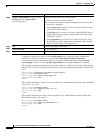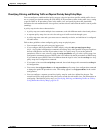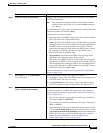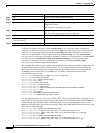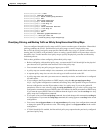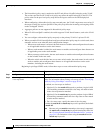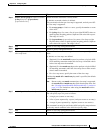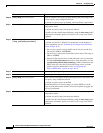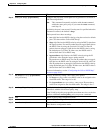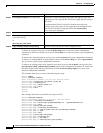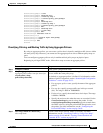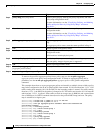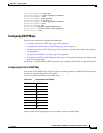
36-56
Catalyst 3750-E and 3560-E Switch Software Configuration Guide
OL-9775-02
Chapter 36 Configuring QoS
Configuring Standard QoS
• The hierarchical policy map is attached to the SVI and affects all traffic belonging to the VLAN.
The actions specified in the VLAN-level policy map affect the traffic belonging to the SVI. The
police action on the port-level policy map affects the ingress traffic on the affected physical
interfaces.
• When configuring a hierarchical policy map on trunk ports, the VLAN ranges must not overlap. If
the ranges overlap, the actions specified in the policy map affect the incoming and outgoing traffic
on the overlapped VLANs.
• Aggregate policers are not supported in hierarchical policy maps.
• When VLAN-based QoS is enabled, the switch supports VLAN-based features, such as the VLAN
map.
• You can configure a hierarchical policy map only on the primary VLAN of a private VLAN.
• When you enable VLAN-based QoS and configure a hierarchical policy map in a switch stack, these
automatic actions occur when the stack configuration changes:
–
When a new stack master is selected, the stack master re-enables and reconfigures these features
on all applicable interfaces on the stack master.
–
When a stack member is added, the stack master re-enables and reconfigures these features on
all applicable ports on the stack member.
–
When you merge switch stacks, the new stack master re-enables and reconfigures these features
on the switches in the new stack.
–
When the switch stack divides into two or more switch stacks, the stack master in each switch
stack re-enables and reconfigures these features on all applicable interfaces on the stack
members, including the stack master.
Beginning in privileged EXEC mode, follow these steps to create a hierarchical policy map:
Command Purpose
Step 1
configure terminal Enter global configuration mode.
Step 2
class-map [match-all | match-any]
class-map-name
Create a VLAN-level class map, and enter class-map configuration
mode. For information about creating a class map, see the “Classifying
Traffic by Using Class Maps” section on page 36-49.
By default, no class maps are defined.
• (Optional) Use the match-all keyword to perform a logical-AND
of all matching statements under this class map. All match criteria
in the class map must be matched.
• (Optional) Use the match-any keyword to perform a logical-OR of
all matching statements under this class map. One or more match
criteria must be matched.
• For class-map-name, specify the name of the class map.
If neither the match-all or match-any keyword is specified, the default
is match-all.
Note Because only one match command per class map is supported,
the match-all and match-any keywords function the same. See
the “Creating Named Standard and Extended ACLs” section on
page 34-15 for limitations when using the match-all and the
match-any keywords.



